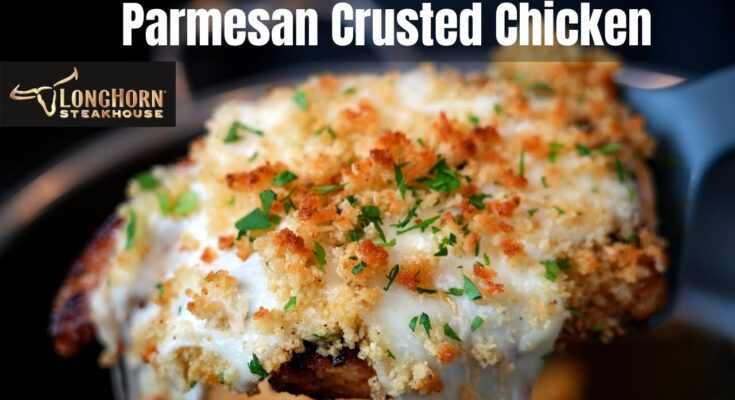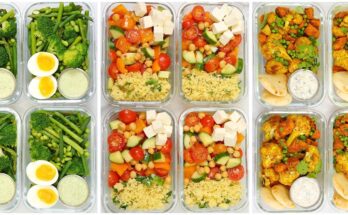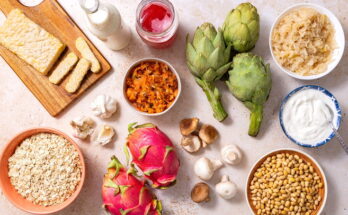Parmesan Crusted Chicken Recipe: Parmesan crusted chicken is one of those dishes that never goes out of style. It’s crispy, juicy, cheesy, and packed with flavor in every bite. Whether you’re cooking for your family, impressing dinner guests, or just want a quick weeknight meal, this recipe has you covered. Let’s dive into this easy, savory classic step by step.
Introduction to Parmesan Crusted Chicken
Let’s be honest—there are a ton of chicken recipes out there. So why does this one stand out?
Parmesan crusted chicken brings together the best of everything: a juicy piece of chicken breast coated in a crispy, cheesy crust that gets perfectly golden brown in the pan or oven. There’s a satisfying crunch with every bite, followed by that creamy, savory goodness from the parmesan. It’s like chicken tenders leveled up—with an Italian twist.
This dish is versatile, too. You can serve it with a side of pasta, a crisp garden salad, roasted veggies, or even sliced over Caesar salad. It’s hearty enough to be the star of dinner and simple enough to whip up during a busy weeknight. And the best part? You only need a few ingredients that are likely already sitting in your pantry or fridge.
If you’re someone who loves crispy fried food but doesn’t want all the grease, this recipe is perfect. You’ll get that same crunch without the mess. Plus, it’s a kid-friendly meal that even picky eaters devour.
Ingredients You’ll Need
Getting this recipe right starts with using fresh, quality ingredients. Let’s go over what you need:
Main Ingredients:
- 2 large boneless, skinless chicken breasts
- 1 cup grated parmesan cheese (freshly grated, not the powdery kind)
- 1/2 cup seasoned breadcrumbs (or panko for extra crunch)
- 2 large eggs
- 1/4 cup all-purpose flour
- Salt and pepper to taste
- 1 tsp garlic powder
- 1 tsp Italian seasoning (optional but recommended)
- 2–3 tablespoons olive oil (or enough for pan-frying)
Substitution Tips:
- Gluten-free? Use almond flour instead of all-purpose and gluten-free breadcrumbs.
- Dairy-free? Swap parmesan with a dairy-free cheese substitute, though texture and flavor may vary slightly.
- Low carb? Skip the breadcrumbs and double up on the parmesan with crushed pork rinds.
Every ingredient in this dish plays a key role. The flour helps the egg stick, the egg binds the crust, and the breadcrumb-parmesan mix gives it that irresistible texture.
You’ll also notice the garlic powder and Italian seasoning—these aren’t mandatory, but they elevate the flavor without any extra work. If you like a little spice, feel free to add a pinch of paprika or cayenne to the breadcrumb mix for a kick.
Kitchen Tools Required
Before you get started, make sure you have the right tools on hand. Don’t worry—nothing fancy is needed here!
Basic Tools:
- Sharp knife and cutting board (for trimming chicken)
- Meat mallet or rolling pin (to pound chicken evenly)
- Shallow bowls or plates (for dredging station)
- Nonstick skillet or cast iron pan
- Tongs or spatula
- Paper towels
Optional but Handy:
- Food thermometer (to check doneness)
- Wire rack (to let chicken rest without getting soggy)
- Oven-safe skillet (if you want to finish it in the oven)
Having your kitchen set up before you start cooking makes everything smoother. It saves time and reduces cleanup later. Trust me, it’s worth the few extra minutes upfront.
Step-by-Step Preparation Instructions
Ready to cook? Here’s the step-by-step breakdown to getting the most tender, crispy Parmesan crusted chicken every single time.
Step 1: Prepare the Chicken
Start by prepping your chicken breasts. If they’re thick in the middle, slice them in half horizontally to create thinner cutlets. This helps them cook faster and more evenly. If you’re working with very large pieces, consider pounding them with a meat mallet or rolling pin until they’re about 1/2 inch thick.
Why does this matter? Uneven chicken cooks unevenly—some parts may dry out while others are still undercooked. Flattening the chicken ensures it stays moist and tender from edge to edge.
After trimming and flattening, pat each piece dry with a paper towel. This is crucial because moisture on the surface can cause the coating to slip off or cook unevenly.
Next, season each piece with salt, pepper, and a sprinkle of garlic powder. Seasoning the chicken directly adds flavor deep into the meat, not just on the crust.
Step 2: Create the Breading Station
Time to get organized. Set up your breading station with three shallow bowls or plates.
- Bowl 1: All-purpose flour, seasoned lightly with salt and pepper
- Bowl 2: Beaten eggs
- Bowl 3: Parmesan cheese and breadcrumbs, mixed together with Italian seasoning
Here’s the trick: mix the parmesan and breadcrumbs really well. This ensures every bite has a good balance of cheese and crunch. Use freshly grated parmesan if possible—it melts better and sticks nicely to the chicken.
Step 3: Coat the Chicken
Now let’s bread the chicken:
- Dredge each piece in the flour, coating all sides. Shake off any excess.
- Dip into the beaten eggs, allowing the excess to drip off.
- Press firmly into the parmesan-breadcrumb mixture. Make sure the chicken is fully coated—press it in so the crust adheres well.
You can even let the coated chicken rest on a wire rack for 5–10 minutes to help the crust set before cooking. This little pause makes a big difference in keeping the coating on while frying.
Step 4: Cook to Crispy Perfection
Heat about 2 tablespoons of olive oil in a skillet over medium heat. When the oil is hot (but not smoking), add the chicken gently. Don’t overcrowd the pan—cook in batches if needed.
Let each piece cook for about 3–5 minutes per side, or until golden brown and cooked through. The internal temperature should reach 165°F (74°C).
Pro tip: Don’t flip the chicken too soon. Let it develop a nice crust before turning. If it sticks, give it another 30 seconds—when it’s ready, it’ll release easily from the pan.
Once done, transfer the chicken to a plate lined with paper towels or a wire rack to rest. Resting allows the juices to redistribute and the crust to stay crispy.
Tips for the Perfect Parmesan Crust
Creating that irresistible, golden-brown crust isn’t magic—it’s a mix of technique, timing, and a few clever hacks. Here are some tried-and-true tips to take your Parmesan crusted chicken from good to gourmet.
Use Freshly Grated Parmesan
It might be tempting to use the pre-grated stuff in the green can, but resist. Freshly grated Parmesan melts better, sticks better, and gives you that crisp, rich flavor that makes this dish shine. If you have a block of Parmigiano-Reggiano, even better.
Pre-shredded cheese is often coated in anti-caking agents, which can prevent it from melting properly and give the crust a gritty texture. Fresh is always worth the extra minute.
Go for Panko Breadcrumbs for Extra Crunch
If you want an even crispier bite, swap traditional breadcrumbs for panko. These Japanese-style breadcrumbs are larger and flakier, creating a lighter, airier crust. When combined with Parmesan, they produce that perfect golden crunch that restaurant chefs love.
You can even toast the panko slightly before breading the chicken to give the crust a head start in color and texture.
Let the Coating Set Before Cooking
After you’ve breaded the chicken, let it sit on a rack or plate for 10 minutes before frying. This simple step helps the coating adhere better during cooking. It prevents the crust from sliding off in the pan and ensures it stays intact from stove to plate.
For an even more secure coating, chill the breaded chicken in the fridge for 15 minutes before frying.
Don’t Crowd the Pan
When you fry the chicken, give it space. If your pan is crowded, the temperature drops, and instead of frying, the chicken starts steaming. That means soggy coating—not what we want.
Cook in batches if needed and keep the heat consistent. Medium to medium-high heat is ideal to crisp the outside while cooking the inside evenly.
Oil Temperature Matters
Too hot, and your crust burns before the chicken cooks. Too cool, and you’ll end up with an oily mess. The sweet spot is around 350°F (175°C). If you don’t have a thermometer, you can test the oil by dropping in a breadcrumb—it should sizzle immediately but not burn.
Use a light-tasting oil like olive oil or avocado oil, which has a higher smoke point and adds a subtle flavor.
Finishing in the Oven (Optional)
If you’re cooking thick chicken breasts or want to ensure doneness without over-frying, finish the chicken in a 375°F (190°C) oven for 5–10 minutes after searing both sides. This ensures the center is fully cooked while preserving that golden crust.
Just transfer the chicken from the pan to an oven-safe dish or leave it in an oven-safe skillet and bake until the internal temp hits 165°F.
Drain Smart
Once cooked, place the chicken on a wire rack or paper towels to drain excess oil. This keeps the crust crispy and prevents it from getting soggy.
Avoid stacking or covering the chicken immediately after cooking. Let it rest for 5 minutes before serving to keep that crunch intact.
Serving Suggestions & Sides
The beauty of Parmesan crusted chicken is that it’s incredibly versatile. Here are a few delicious ideas to turn it into a full meal:
Classic Combos:
- Pasta: Serve with spaghetti tossed in olive oil, garlic, and cherry tomatoes.
- Salad: Pair with Caesar or arugula salad for a light, zesty meal.
- Veggies: Roasted asparagus, sautéed green beans, or a medley of seasonal vegetables.
- Potatoes: Mashed, roasted, or even fries—because, why not?
Sauce It Up:
- Marinara or tomato basil sauce for an Italian twist.
- Honey mustard or garlic aioli for dipping.
- Creamy Alfredo for a rich, indulgent vibe.
You can even turn this chicken into a killer sandwich—just add lettuce, tomato, and a soft bun!
Storing and Reheating Leftovers
Have leftovers? Lucky you. Here’s how to keep that crispy magic alive:
- Storage: Store in an airtight container in the fridge for up to 3 days.
- Reheating: Skip the microwave. Reheat in a 375°F (190°C) oven for 10–12 minutes or air fryer for 5–7 minutes to restore the crunch.
Avoid covering the chicken tightly when it’s still warm—trapped steam softens the crust.
FAQs about Parmesan Crusted Chicken Recipe
1. What is Parmesan Crusted Chicken?
Parmesan Crusted Chicken is a flavorful dish where chicken breasts are coated with a crispy mixture of grated Parmesan cheese, breadcrumbs, and seasonings, then baked or pan-fried to golden perfection.
2. Can I use pre-grated Parmesan cheese?
Yes, you can use store-bought grated Parmesan. However, for the best flavor and texture, freshly grated Parmesan cheese is highly recommended.
3. Is this recipe gluten-free?
Not by default. Traditional breadcrumbs contain gluten. To make it gluten-free, use gluten-free breadcrumbs or almond flour as a substitute.
4. Can I bake instead of fry the chicken?
Absolutely! Baking is a healthier option. Simply place the coated chicken on a baking sheet lined with parchment paper and bake at 400°F (200°C) for 20–25 minutes or until crispy and fully cooked.
5. What sides go well with Parmesan Crusted Chicken?
This dish pairs perfectly with mashed potatoes, steamed vegetables, pasta, or a fresh green salad.
6. How do I keep the crust crispy?
For maximum crispiness, pat the chicken dry before coating, don’t overcrowd the pan or baking sheet, and serve immediately after cooking.
7. Can I make it ahead of time?
While best served fresh, you can prepare the chicken and store it uncooked in the fridge for up to 24 hours before cooking.
Conclusion
Parmesan crusted chicken is a dish that delivers maximum flavor with minimal fuss. With just a few simple ingredients and easy steps, you get a restaurant-worthy meal right at home. From the satisfying crunch of the Parmesan crust to the juicy chicken inside, every bite is a winner.
Whether it’s a weekday dinner or a special occasion, this recipe is sure to become a favorite in your home. So, grab that Parmesan and get cooking—your taste buds will thank you.



